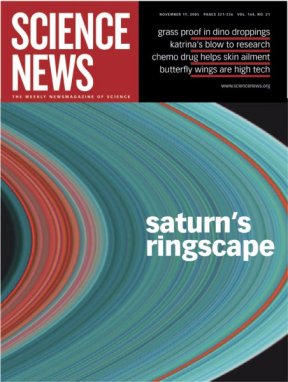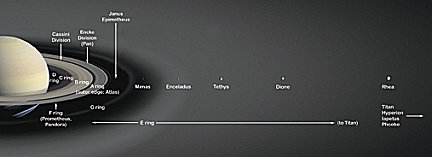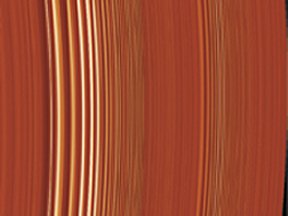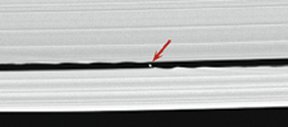Groovy Science
Cassini gets the skinny on Saturn's rings
By July 1610, Galileo Galilei had already viewed Jupiter and its large moons, watched mysterious dark spots march across the sun, and studied craters on the moon. But when he turned his small, homemade telescope toward Saturn, Galileo was flummoxed. Unlike any other known planet, Saturn appeared to be a bright body closely flanked by two dimmer ones.




“I discovered another very strange wonder, which I should like to make known to their Highnesses,” he wrote on July 30 to his patrons in the royal family of Medici. “[T]he star of Saturn is not a single star but is a composite of three, which almost touch each other.”
So puzzling was the observation that Galileo kept it secret while he made further studies, circulating the finding to his patrons only in a Latin anagram: “Smais int milmep oet ale umibunen ugttauir as.” Unscrambled and translated into English, the anagram reads: “I have observed the highest planet in triform.”
In a sketch that Galileo drew of Saturn in 1616, handles or “ears,” as he called them, appear on either side of the main body. “I do not know what to say in a case so surprising,” he wrote.
Galileo died not knowing that his observations marked the first viewings of Saturn’s rings.
Nowadays, the rings can be seen easily through a backyard telescope, yet they remain one of the most riveting sights in the heavens. Up close, Saturn’s rings have proved even more fascinating.
When the two Voyager spacecraft flew past Saturn in the early 1980s, they revealed new moons and ripples in the icy rings, which from afar resemble the grooves of a vinyl phonograph record. Now, the Cassini spacecraft, which entered orbit around Saturn last year, has completed the most thorough examination ever of the rings.
Until last May, the craft had spent most of its time orbiting Saturn’s equator. That orientation is great for close-up studies of the planet’s moons but provides only an obscured, edge view of the intricate ring system.
Then, Cassini got a ringside seat. Just as scientists had planned, the craft rose out of the equatorial plane and for the next 5 months viewed the rings from above and below the planet’s equator. From those perches, it has studied the full breadth of the rings in unprecedented detail.
Ring primer
With the flood of new data, astronomers may be on the verge of answering some centuries-old questions about the rings.
“It’s amazing to me that something as prominent in the solar system as the rings still has so many fundamental unanswered questions,” says Cassini scientist Joshua Colwell of the University of Colorado in Boulder. “How old are they? How did they form? and How will they evolve?” he asks.
The rings are vast. They fan out across a region of space larger than the separation between the Earth and its moon but are only a few meters thick. The proportions are equivalent to those of a piece of paper big enough to blanket San Francisco. Icy rings also girdle Uranus and Neptune, but they pale in comparison to Saturn’s.
Labeled alphabetically in order of their discovery, the rings of Saturn have seven main bands. From the planet outward, they’re known as D, C, B, A, F, G and E. The major ring groups are C, B, and A, with B and A easily visible in telescopes on Earth. F, G, and E are fainter and narrower. The large gap between rings B and A is called the Cassini division.
Seen from afar, the rings look like solid hoops, but in reality, they’re a blizzard of particles, mostly water ice mixed with dust. Circling Saturn like cars on a crowded racetrack, the particles are herded by the gravity of the big planet’s many moons. Including particles as fine as smoke and as big as barns, the total mass of the rings is no greater than that of the 200-kilometer-wide moon Mimas, one of Saturn’s smaller satellites.
The moon connection could be even more intimate than that. Astronomers have proposed that the rings formed when an icy Saturnian moon got smashed to bits by a meteoroid or when a comet or moon that came too close to its parent planet was torn apart by gravitational stresses. Simulations of these scenarios indicate that a breakup would generate a swirling cloud of material but that the planet’s gravity, which is highest at the equator, would soon flatten the debris into an equatorial disk.
It’s the intricate structures of the rings that fascinates Cassini lead scientist Carolyn Porco of the Space Science Institute in Boulder, Colo. Some of the rings have sharp edges, and some are scalloped. Many have clumps that form and dissemble as well as a variety of waves and spiral patterns that travel through the rings like ripples in a pond.
All these patterns, notes Porco, are grand gestures of gravity, driven by the interactions of moons that lie embedded in the rings or near them. The moons both corral and disturb the icy-ring particles.
Detailed analyses of the complex dance between the rings and the moons may uncover clues to an even bigger puzzle: how planetary systems form. As Porco and other planetary scientists see it, the rings provide a scaled-down version of the primordial disk of gas, dust, and ice particles that spawned the solar system’s planets, including Saturn, about 4.5 billion years ago.
Gravity at play
Some of Saturn’s moons are particularly effective in sculpting the rings because they have a special relationship, called a resonance, with the rings’ particles. In this relationship, a group of orbiting ring particles regularly returns to a spot at the same time that a moon comes around after a certain number of orbits. In this configuration, the particles’ repeated tugs from a moon add up, just as pushes on a child’s swing at just the right time reinforce each other. The reinforcing tugs create waves in Saturn’s rings.
Cassini has imaged a record number of resonance-induced waves, many of them smaller and subtler than those found by the Voyager craft. In one type of wave, known as a spiral-density wave, a moon outside a ring pulls at particles within a ring. In response, the ring’s particles form clumps, and the clumps pull together even more particles. This causes a spiral wave to slowly travel through the ring.
Moons that lie above or below the ring plane can generate another type of oscillation, known as a bending wave. In such cases, the moon lifts ring particles out of the plane in which they normally orbit Saturn, causing them to bob up and down like gentle swells in an ocean. The waves are a few kilometers high and hundreds of kilometers wide.
Measuring the amplitude of the waves can reveal the density of the rings, says Larry Esposito of the University of Colorado. Such measurements may also indicate the mass of the perturbing moon or even the presence of moons not previously recognized.
Such is the case for a tiny moon that Cassini has now spotted in the Keeler gap, which lies just inside the outer edge of Saturn’s A ring. Early in the mission, the craft had found a set of spiky and wispy wavelike features in the gap’s outer edge, prompting scientists to suspect that a moon was lurking there. The waves resemble those found in Saturn’s F ring and the Encke gap, which were already known to have been generated by moons.
Astronomers identified the suspected moon in a series of images taken by Cassini last May. Provisionally named S/2005 S1, the tiny, newfound moon has a diameter of about 7 km and reflects about half the sunlight that falls on it, similar to the brightness of neighboring ring particles.
Two new findings about Saturn’s F ring provide graphic evidence of the interplay between moons and rings. Visible-light images taken by Cassini in August show that ghostly strands of material previously known to flank the core of the F ring are actually connected and form a helical structure wound like a spring around the planet. Scientists speculate that the structure may be generated by moonlets flying through the F ring, disturbing groups of particles and smearing them out.
“The whole [F-ring] region is probably just a chaotic bumper car zone of moonlets that are getting scattered,” suggests Jeff Cuzzi of NASA’s Ames Research Center in Moffett Field, Calif.
A chunk of material that Cassini has spied in the F ring may be one of those moonlets, says Joseph Burns of Cornell University.
In the Oct. 27 Nature, researchers reveal that Cassini has caught the moon Prometheus red-handed, stealing material from the F ring. New images from the craft show that Prometheus, discovered by the Voyager 1 craft in 1980, has opened tiny, channel-like gaps in the F ring and that a dusty streamer links the moon with the narrow, twisted ring.
Carl D. Murray of Queen Mary, University of London and his colleagues note that Prometheus approaches and recedes from the
F ring every 14.7 hours. The team’s simulations indicate that each time that the moon begins receding, it pulls out strands of particles from the narrow, twisted ring. One orbit later, according to the simulations, Saturn’s tug distends the region from which the strands were stolen, creating the channels seen in the Cassini images.
Murray and his collaborators predict that Prometheus’ disturbance of the F ring will intensify through 2009, when the orbits of the moon and the ring will have their closest periodic encounters.
From measurements of the light filtering through the A ring from a background star, Cassini researchers recently announced they have the best evidence to date for a curious pattern of clumps that resembles the spokes of a pinwheel. The striated pattern arises when the gravity of ring particles pulls them together, only to be smeared out by the gravitational stresses from Saturn, says Phil Nicholson of Cornell University.
Past and future
Recent Cassini observations are providing new clues about the past and future evolution of Saturn’s rings.
Cassini images released by NASA in September reveal changes in Saturn’s D ring, the innermost ring, over the 25 years since the Voyager craft took a look at the system. One of the strands, or ringlets, that make up the D ring is now only one-tenth as bright as it appeared in 1981, and has migrated toward Saturn by 200 km.
“There’s enormous time variability in the rings,” says Cuzzi. New clumps of material have appeared in rings just since July 2004 when Cassini began orbiting the system. “Rubble-pile moonlets”—small, loosely bound collections of icy particles—appear to be continually assembling and breaking apart in the rings, adds Colorado’s Colwell.
But there’s no consensus among Cassini scientists about how long the Saturnian ring system has been in place and how long it might last. Cuzzi argues that the entire system is young, no more than a few hundred million years old. Two lines of evidence—one related to appearance, the other to dynamics—point to the rings’ youth, he maintains.
The vast area encompassed by the rings acts like a giant net for catching meteoroids, which continually bombard the Saturn system. Over time, scientists would expect the bombardment to pollute and darken the icy-ring particles, yet images from the Voyager missions and from Cassini show that the rings appear bright and fresh.
Furthermore, both simulations and observations indicate that the ring particles are giving up angular momentum to small moons that orbit the outer part of the ring system. Over the next few hundred million years, argues Cuzzi, the energy transfer will cause particles in the outer parts of the ring to fall toward the planet while nudging the moon away, so that the ring structure will collapse.
The energy transfer between ring particles and moons has an analog in a more complex system for which few direct observations exist—the disks of ice, gas, and dust from which planets emerge around young stars, notes Porco. Energy transferred from tiny particles in the protoplanetary disk to embryonic planets is a key factor in determining just how long the disk will remain intact and how massive any planets emerging from the disk materials can become. Most protoplanetary disks vanish after a few hundred million years, astronomers have concluded.
While acknowledging the analogy between Saturn’s ring system and protoplanetary disks, Esposito maintains that the planet’s rings may be as ancient as the 4.5-billion-year-old solar system and could remain visible for billions of years to come.
In Esposito’s view, the basic structure of the rings has endured for eons, although they undergo constant renewal.
Moreover, he notes, if the rings were young, that would mean that a large comet or moon—the presumed source of the rings—would have to have broken apart in the vicinity of Saturn within the past several hundred million years. Computer simulations indicate that there’s only about a 1 percent chance that such an event occurred so recently. In contrast, when the solar system was young, such collisions were much more likely.
Esposito and Colwell’s analysis also suggests that once in place, the rings take much longer to collapse than Cuzzi and other astronomers argue. According to Esposito, the rings are subject to only gentle disturbances, and their basic pattern can last for billions of years.
Temperature maps taken by Cassini suggest that the ring particles collide at extremely slow velocities and barely disturb each other’s orbits. The maps reveal that the particles rotate slowly, compared with their orbital period. If powerful collisions were commonplace, they would have caused most of the particles to spin much more rapidly, says Linda Spilker of NASA’s Jet Propulsion Laboratory in Pasadena, Calif.
Next summer, Cassini will again be in a prime viewing position. Observations at that time and during one future interval may give astronomers a better sense of how long the solar system’s most famous rings are likely to last. Before Saturn’s rings do disappear, some future Galileo may find an even more spectacular set of ears around a planet orbiting another star.







